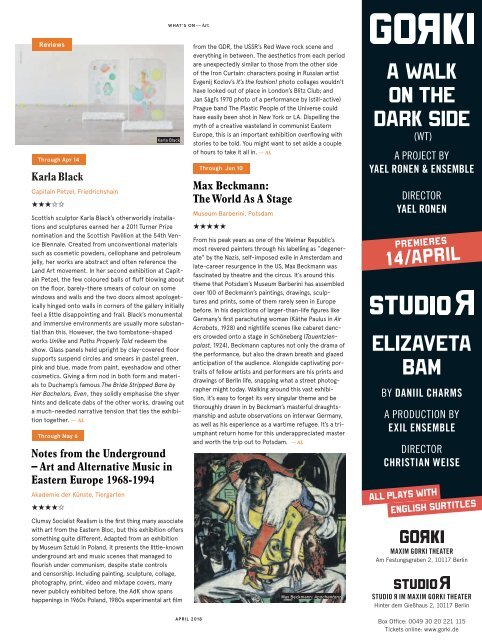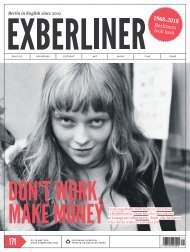EXBERLINER Issue 170, April 2018
You also want an ePaper? Increase the reach of your titles
YUMPU automatically turns print PDFs into web optimized ePapers that Google loves.
WHAT’S ON— Art<br />
Reviews<br />
Through Apr 14<br />
Karla Black<br />
Capitain Petzel, Friedrichshain<br />
★★★✩✩<br />
Scottish sculptor Karla Black’s otherworldly installations<br />
and sculptures earned her a 2011 Turner Prize<br />
nomination and the Scottish Pavillion at the 54th Venice<br />
Biennale. Created from unconventional materials<br />
such as cosmetic powders, cellophane and petroleum<br />
jelly, her works are abstract and often reference the<br />
Land Art movement. In her second exhibition at Capitain<br />
Petzel, the few coloured balls of fluff blowing about<br />
on the floor, barely-there smears of colour on some<br />
windows and walls and the two doors almost apologetically<br />
hinged onto walls in corners of the gallery initially<br />
feel a little disappointing and frail. Black’s monumental<br />
and immersive environments are usually more substantial<br />
than this. However, the two tombstone-shaped<br />
works Unlike and Paths Properly Told redeem the<br />
show. Glass panels held upright by clay-covered floor<br />
supports suspend circles and smears in pastel green,<br />
pink and blue, made from paint, eyeshadow and other<br />
cosmetics. Giving a firm nod in both form and materials<br />
to Duchamp’s famous The Bride Stripped Bare by<br />
Her Bachelors, Even, they solidly emphasise the shyer<br />
hints and delicate dabs of the other works, drawing out<br />
a much-needed narrative tension that ties the exhibition<br />
together. — AL<br />
Through May 6<br />
Notes from the Underground<br />
– Art and Alternative Music in<br />
Eastern Europe 1968-1994<br />
Akademie der Künste, Tiergarten<br />
★★★★✩<br />
Karla Black<br />
Clumsy Socialist Realism is the first thing many associate<br />
with art from the Eastern Bloc, but this exhibition offers<br />
something quite different. Adapted from an exhibition<br />
by Museum Sztuki in Poland, it presents the little-known<br />
underground art and music scenes that managed to<br />
flourish under communism, despite state controls<br />
and censorship. Including painting, sculpture, collage,<br />
photography, print, video and mixtape covers, many<br />
never publicly exhibited before, the AdK show spans<br />
happenings in 1960s Poland, 1980s experimental art film<br />
from the GDR, the USSR’s Red Wave rock scene and<br />
everything in between. The aesthetics from each period<br />
are unexpectedly similar to those from the other side<br />
of the Iron Curtain: characters posing in Russian artist<br />
Evgenij Kozlov’s It’s the fashion! photo collages wouldn’t<br />
have looked out of place in London’s Blitz Club; and<br />
Jan Ságl’s 1970 photo of a performance by (still-active)<br />
Prague band The Plastic People of the Universe could<br />
have easily been shot in New York or LA. Dispelling the<br />
myth of a creative wasteland in communist Eastern<br />
Europe, this is an important exhibition overflowing with<br />
stories to be told. You might want to set aside a couple<br />
of hours to take it all in. — AL<br />
Through Jun 10<br />
Max Beckmann:<br />
The World As A Stage<br />
Museum Barberini, Potsdam<br />
★★★★★<br />
From his peak years as one of the Weimar Republic’s<br />
most revered painters through his labelling as “degenerate”<br />
by the Nazis, self-imposed exile in Amsterdam and<br />
late-career resurgence in the US, Max Beckmann was<br />
fascinated by theatre and the circus. It’s around this<br />
theme that Potsdam’s Museum Barberini has assembled<br />
over 100 of Beckmann’s paintings, drawings, sculptures<br />
and prints, some of them rarely seen in Europe<br />
before. In his depictions of larger-than-life figures like<br />
Germany’s first parachuting woman (Käthe Paulus in Air<br />
Acrobats, 1928) and nightlife scenes like cabaret dancers<br />
crowded onto a stage in Schöneberg (Tauentzienpalast,<br />
1924), Beckmann captures not only the drama of<br />
the performance, but also the drawn breath and glazed<br />
anticipation of the audience. Alongside captivating portraits<br />
of fellow artists and performers are his prints and<br />
drawings of Berlin life, snapping what a street photographer<br />
might today. Walking around this vast exhibition,<br />
it’s easy to forget its very singular theme and be<br />
thoroughly drawn in by Beckman’s masterful draughtsmanship<br />
and astute observations on interwar Germany,<br />
as well as his experience as a wartime refugee. It’s a triumphant<br />
return home for this underappreciated master<br />
and worth the trip out to Potsdam. — AL<br />
Max Beckmann: Apachentanz<br />
a Walk<br />
on the<br />
dark side<br />
(WT)<br />
A PROJECT BY<br />
YAEL RONEN & ENSEMBLE<br />
DIRECTOR<br />
YAEL RONEN<br />
PREMIERES<br />
14/APRIL<br />
ELIZAVETA<br />
BAM<br />
BY DANIIL CHARMS<br />
A PRODUCTION BY<br />
EXIL ENSEMBLE<br />
DIRECTOR<br />
CHRISTIAN WEISE<br />
ALL PLAYS WITH<br />
ENGLISH SURTITLES<br />
MAXIM GORKI THEATER<br />
Am Festungsgraben 2, 10117 Berlin<br />
STUDIO IM MAXIM GORKI THEATER<br />
Hinter dem Gießhaus 2, 10117 Berlin<br />
APRIL <strong>2018</strong><br />
Box Office: 0049 30 20 221 115<br />
Tickets online: www.gorki.de

















